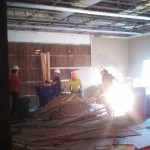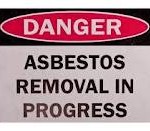Entries tagged with “building survey”.
Did you find what you wanted?
Fri 6 Sep 2013
Posted by admin under Asbestos, Building Survey, Cadmium, Carcinogen, Exposure, Lead, Management, OSHA, Uncategorized
Comments Off on Let me give you a “hypothetical” worst-case scenario:
Hypothetically (and allegedly):
- You receive a project as a subcontractor.
- You are verbally told no asbestos or lead onsite. Only that’s not true.
- There is asbestos, and you, and multiple other subs, have disturbed it.
- The prime contractor says, “oops”. Has the materials tested, and then blames the owner for not letting them know.
- OSHA is called and citations are issued to the owner and GC for not testing and telling people.
- A year goes by and now both the owner and GC are being sued by 5 employees for $10,000,000 (yep $10 million, that’s the max BTW).
- As a footnote: this incidentally is not a worker compensation case (yet) since they are not suing their employer (they are suing the GC and owner)
Even if the employees don’t win $10m, are you prepared for: the headache, loss of client-relationship, trust breaking? Here’s a similar hypothetical article about such a situation.
On the flip side, here are some positive things you can do:
- get a written copy of the building survey (lead & asbestos) ALWAYS. (you might also ask for cadmium, radon, other possible hazardous substances)
- Train your employees about asbestos prior to having to deal with it.
- Give employees the power to “stop work” if they are suspicious of possible asbestos containing material (PACM).
- When handing out a building survey to your subs, get their acknowledgment (in writing, of course)
- Fight your OSHA citations. Go to your informal conference. Present your evidence and, at the very least, beg for forgiveness.
Wed 18 Jul 2012
Posted by admin under Air Monitoring, Asbestos, Building Survey, Hazard Communication, Management
Comments Off on What if you’ve had asbestos exposure?
 Occasionally (actually, far too often), I hear from a subcontractor who was told by the General Contractor (or owner) there is no asbestos onsite. Then, after they have been working for a month they find out it actually IS asbestos, and they were disturbing it. What do you do?
Occasionally (actually, far too often), I hear from a subcontractor who was told by the General Contractor (or owner) there is no asbestos onsite. Then, after they have been working for a month they find out it actually IS asbestos, and they were disturbing it. What do you do?
The first thing to do is stop work. Do not try to clean it up. Call an abatement contractor. They will identify the asbestos onsite, clean it up, and provide an airborne clearance test.
Next, you will need to provide awareness training (or better, let the abatement company provide it). Ideally this will occur on the day you start back working. Train everyone onsite about asbestos.
Finally, you (as the safety manager), need to identify and characterize the exposure to the employees. It should probably be a formal letter written to the owner, general contractor and employees.
Here are some tips on writing the letter:
- include employee names, work hours, type of work, PPE worn, and locations they were working
- describe the asbestos. Amount found, locations, type, estimated amount disturbed.
- describe remedy process and steps taken. Names of GC, owner, abatement company, airborne levels found. Who was trained afterwards.
- describe how things will change in the future. Here’s a tip: Â any building before 1985 WILL have a building survey performed for asbestos….in writing.
Really, one exposure to asbestos is probably* not enough to contract a disease (asbestosis, or mesothelioma). It will take 15-30 years for symptoms to appear. But, it might be worth the “goodwill” to send affected employees into a occupational health doctor for a check up. The physician will reassure the employee and may provide some comfort.
*asbestos is a carcinogen. Greater exposure = greater chance of cancer. no amount is safe.
Mon 16 Apr 2012
Occasionally I hear of certain (construction) trades having to touch asbestos. Usually it is an electrician, sheetmetal worker, carpenter, or plumber.
How it usually happens is that they have a small remodel/install/repair. They must cut through the asbestos to install the item (duct work, electrical, plumbing). Be careful. If you look at OSHA’s definition you may not be able to perform this type of work without specific training. In some cases, 16 hours of asbestos-specific training!
 If you work with any type of asbestos (or, are even near it) you must have Class IV (4) training. This is a 2-hour training which is defined as, “…contact, but DO NOT disturb asbestos…”. As a contractor, you want to make sure you fall under this type of training. The alternative is,
If you work with any type of asbestos (or, are even near it) you must have Class IV (4) training. This is a 2-hour training which is defined as, “…contact, but DO NOT disturb asbestos…”. As a contractor, you want to make sure you fall under this type of training. The alternative is,
Class III (3) training. This type of training where employees are, “likely to disturb” asbestos. Â If you think you disturbed asbestos in your activities, you REALLY should prevent it. Here are some suggestions for making sure you never disturb asbestos.
- Always, always get (in writing) a building survey for asbestos (and leaded paint) before performing work
- Train your employees in how to recognize asbestos, etc. (Class IV training as a minimum. See my earlier post)
- Establish procedures for how you will prevent contact with asbestos
If you must touch (and possibly disturb it) asbestos then also,
- Have specific procedures for how you prevent exposure
- Have PPE (including respirators)
- Obtain air monitoring data while you are performing your activities – document that you DO NOT disturb the asbestos
- Dispose of the material properly
Asbestos is one of those hazards you can’t ignore. If you are not doing the correct procedures, it will bite you (a claim, a citation, a lawsuit, horrible PR, or someone getting ill!).


